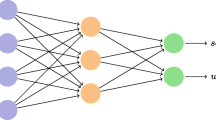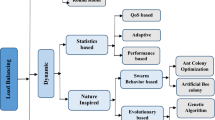Abstract
Automatic service composition is the generation of a business process to fulfill business goals that cannot be fulfilled by individual services. Planning algorithms are frequently used to solve this problem. In addition to satisfying functional goals, recent research is geared toward selecting the best services to optimize the QoS of the result business process. Without considering QoS, the planning algorithm normally searches for the shortest plan, which actually implies the unit execution time for each service. With QoS, a longer plan may have better QoS values and thus is preferred over a shorter one. In this paper, we are motivated to combine a systematic search algorithm like Dijkstra’s algorithm with a planning algorithm, GraphPlan, to achieve both functional goals and QoS optimization at the same time. The planning graph generated by GraphPlan is a compact representation of all execution paths, which makes it feasible to apply Dijkstra’s principle. In our new QoSGraphPlan algorithm, we extend Dijkstra’s algorithm from working on a single-source graph to working on the planning graph whose nodes have multiple sources. Using our method, we can get the best QoS value for throughput and response time in polynomial time when they are the single criteria. For the other QoS criteria, such as execution time, reputation, successful execution rate, and availability, our algorithm is exponential for both single criterion problem and multiple criteria problem. In this case, we extend QoSGraphPlan with beam search to solve the combination explosion problem. As our algorithms search for an optimal solution during the process of constructing the planning graph, they belong to the category of anytime algorithms that return better solutions if they keep running for a longer time.









Similar content being viewed by others
Notes
For stateful services, we have developed a modeling technique to convert the sequential orders of each operation into its preconditions and postconditions [24]. Therefore, if we have QoS values for each operation in a stateful service, the methods developed in this paper can be applied to both stateful and stateless services.
We take the value of throughput of a service as its execution price for this experiment.
We take the value of throughput of a service as its execution price and the value of response time as its reputation for this experiment.
References
Berbner R, Spahn M, Repp N, Heckmann O, Steinmetz R (2006) Heuristics for qos-aware web service composition. In: Proceedings of ICWS, pp 72–82
Bleul S (2009) Web service challenge rules. http://ws-challenge.georgetown.edu/wsc09/downloads/WSC2009Rules-1.1.pdf
Blum AL, Furst ML (1997) Fast planning through planning graph analysis. Artif Intell J 90(1–2):225–279
Börzsönyi S, Kossmann D, Stocker K (2001) The skyline operator. In: Proceedings of ICDE, pp 421–430
Bouguettaya A, Qi Y (2011) Service-centric framework for a digital government application. IEEE Trans Serv Comput 4(1):3–16
Canfora G, Di Penta M, Esposito R, Villani ML (2005) An approach for qos-aware service composition based on genetic algorithms. In: Proceedings of GECCO, pp 1069–1075
Chen M, Yan Y (2012) Redundant service removal in qos-aware service composition. In: Proceedings of IEEE ICWS, pp 431–439
Cui LY, Kumara S, Lee D (2011) Scenario analysis of web service composition based on multi-criteria mathematical programming. Inf Serv Sci 3(3)
Fredman ML, Tarjan RE (1987) Fibonacci heaps and their uses in improved optimalization problems. J ACM, 34
Ghallab DNM, Traverso P (2004) Automated planning: theory and practice. Morgan Kaufmann Publishers, Los Altos
El Haddad J, Manouvrier M, Rukoz M (2010) Tqos: transactional and qos-aware selection algorithm for automatic web service composition. IEEE Trans Serv Comput 3(1):73–85
Hassine AB, Matsubara S, Ishida T (2006) A constraint-based approach to horizontal web service composition. In: Proceedings of ISWC, pp 130–143
Hoffmann J, Nebel B (2001) The FF planning system: fast plan generation through heuristic search. J Artif Intell Res 14:253–302
Huang Z, Jiang W, Hu S, Liu Z (2009) Effective pruning algorithm for qos-aware service composition. In: Proceedings of CEC, pp 519–522
Jiang W, Zhang C, Huang Z, Chen M, Hu S, Liu Z (2010) Qsynth: a tool for qos-aware automatic service composition. In: Proceedings of ICWS, pp 42–49
LaValle SM (2006) Planning algorithms, Cambridge
May Chan KS, Bishop J, Baresi L (2007) Survey and comparison of planning techniques for web service composition. Technical report Dept Computer Science, University of Pretoria
Nguyen XT, Kowalczyk R, Phan MT (2006) Modelling and solving qos composition problem using fuzzy discsp. In: Proceedings of ICWS, pp 55–62
OASIS (2007) Uddi version 2.04 api specification. http://uddi.org/pubs/ProgrammersAPI-V2.04-Published-20020719.htm
OASIS (2007) Web services business process execution language (ws-bpel). http://www.oasis-open.org/committees/tc_home.php?wg_abbrev=wsbpel
Papazoglou MP, Traverso P, Dustdar S, Leymann F (2008) Service-oriented computing: a research roadmap. Int J Co-op Inf Syst 17(2):223–255
Peer J (2005) Web service composition as AI planning—a survey. Technical report, University of St. Gallen
Pistore M, Traverso P, Bertoli P (2005) Automated composition of web services by planning in asynchronous domains. In: Proceedings of ICAPS, pp 2–11
Poizat P, Yan Y (2010) Adaptive composition of conversational services through graph planning encoding. In: Proceedings of IsoLA, pp 35–50
Qi Y, Bouguettaya A (2010) Computing service skyline from uncertain qows. IEEE Trans Serv Comput 3(1):16–29
Rao J, Su X (2004) A survey of automated web service composition methods. In: Proceedings of 1st Internationsl WS on semantic web services and web process composition, SWSWPC
Triantaphyllou E (2000) Multi-criteria decision making: a comparative study
W3C (2004) Owl web ontology language overview. http://www.w3.org/TR/owl-features/ Retrieved 2011–06-30
W3C (2007) Semantic annotations for wsdl and xml schema (sawsdl). http://www.w3.org/TR/sawsdl/ Retrieved 2011–06-30
W3C (2007) Soap version 1.2 part 1: messaging framework (second edition). http://www.w3.org/TR/soap12-part1/#intro. Retrieved 2011–06-30
W3C (2007) Web services description language (wsdl) version 2.0. http://www.w3.org/TR/wsdl20/ Retrieved 2011–06-30
Wikipedia. Beam search. http://en.wikipedia.org/wiki/Beam_search Retrieved 2011–09-02
Wikipedia. Dijkstra’s algorithm. http://en.wikipedia.org/wiki/Dijkstra’27_algorithm Retrieved 2011–06-30
Yan Y, Poizat P, Zhao L (2010) Repair vs. recomposition for broken service compositions. In: Proceedings of ICSOC, pp 152–166
Yan Y, Xu B, Gu Z (2008) Automatic service composition using and/or graph. In: Proceedings of CEC/EEE, pp 335–338
Yan Y, Xu B, Gu Z, Luo S (2009) A qos-driven approach for semantic service composition. In: Proceedings of CEC, pp 523–526
Yu T, Zhang Y, Lin K-J (2007) Efficient algorithms for web services selection with end-to-end qos constraints. ACM Trans Web, 1(1)
Zeng L, Benatallah B, Ngu AHH, Dumas M, Kalagnanam J, Chang H (2004) Qos-aware middleware for web services composition. IEEE Trans Softw Eng 30(5):311–327
Zeng L, Benatallah B, Dumas M, Kalagnanam J, Sheng QZ (2003) Quality driven web services composition. In: Proceedings of WWW, pp 411–421
Zheng X, Yan Y (2008) An efficient web service composition algorithm based on planning graph. In: Proceedings of ICWS, pp 691–699
Author information
Authors and Affiliations
Corresponding author
Additional information
This work is supported by project “Building Self-Manageable Web Service Process” of Canada NSERC Discovery Grant, RGPIN/298362-2007.
Rights and permissions
About this article
Cite this article
Yan, Y., Chen, M. Anytime QoS-aware service composition over the GraphPlan. SOCA 9, 1–19 (2015). https://doi.org/10.1007/s11761-013-0134-6
Received:
Revised:
Accepted:
Published:
Issue Date:
DOI: https://doi.org/10.1007/s11761-013-0134-6




